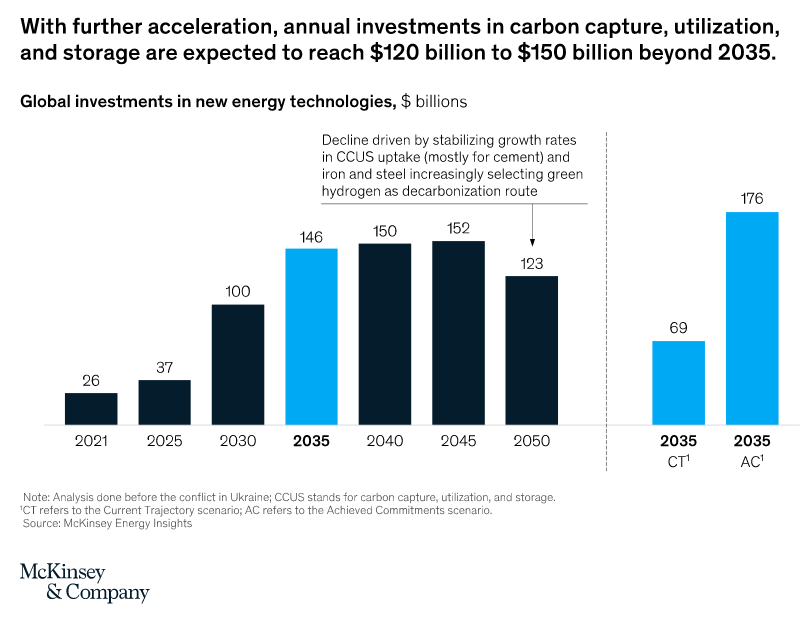The global capacity of Carbon Capture, Utilization and Storage (CCUS) technologies will need to be at least 60 times greater than current levels, and up to 120 times greater by 2050, to achieve a net-zero emissions world.
This is the main conclusion of a report published by McKinsey that assesses current global CCUS capacity, which currently covers less than half of annual global emissions. It also examines the likely need to expand CCUS to meet the zero emissions commitments made by nations, regions and states.
The report warns that the CCUS sector has “struggled to find its footing” over the past three decades; cautions that its success and scale-up are by no means guaranteed; and stresses that the policy outlook for these technologies is not sufficient in most markets because more direct and indirect incentives are needed, as well as more targeted regulatory enablement, including permitting of developers and enforcement of product standards.
Moreover, the report cites greater clarity on the future of carbon pricing as a key policy enabler. Without these enablers, McKinsey notes, revenue streams are cautious and still taking shape.
“Companies have been willing to develop plans, but are hesitant to commit capital without regulatory certainty, which has led to cautious approaches to spending on project development beyond feasibility studies,” the report states.

You may also be interested in > DNV: “Offshore wind energy could increase more than 50-fold by 2050”
More Details
McKinsey notes that many carbon capture buyers are opting for nature-based options for the time being. This is partly because this approach is more mature than some emerging technologies, and some see it as a better way to ensure emissions capture. The social and nature-related benefits are also attractive, and the consultancy believes this trend will continue.
But the report concludes that even in “conservative” scenarios, in which CCUS expands at a reduced scope and pace, global capacity is likely to increase 60-fold between 2020 and 2050. It also posits a scenario in which it increases 120-fold in that time frame, or more. This level of increase is what it claims would be needed in the net-to-zero transition. In both scenarios, capacity growth accelerates after 2030.
McKinsey believes that early adopters of commercial CCUS at scale will be companies in heavy industrial sectors, which will need to use it in their own facilities to meet national net-zero transition requirements.
According to the report, their processes will be difficult to overcome with other technologies, but their materials will be needed in the future for critical products and infrastructure. This approach is called “Point Source Industrial CCUS.” Other forms of CCUS, such as bioenergy with CCUS and direct air capture (DAC), are considered important, but are likely to be scaled up later.
The report notes that a 120-fold increase in CCUS capacity would require an investment of $130 billion per year through 2050, and calls for a combination of public and private financing, as it will not be possible to achieve this financing solely through one of the two routes.
“For decades, widespread adoption of CCUS has been predicted to be just around the corner, but has so far failed to materialize. Today, however, global decarbonization goals and growing demand for green consumer products make rapid scale-up of CCUS not only possible, but necessary.”
Krysta Biniek, expert in McKinsey’s Sustainability and ESG team
To read the report, click here
Written by Antonio Vilela




